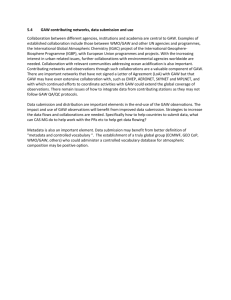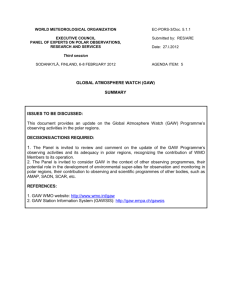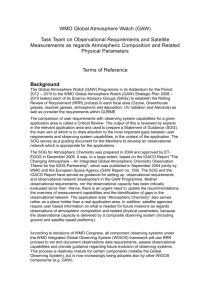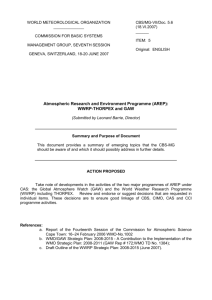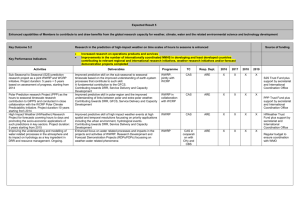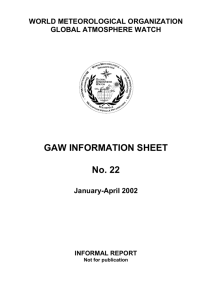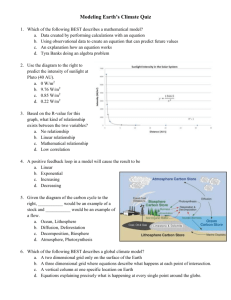doc - WMO
advertisement
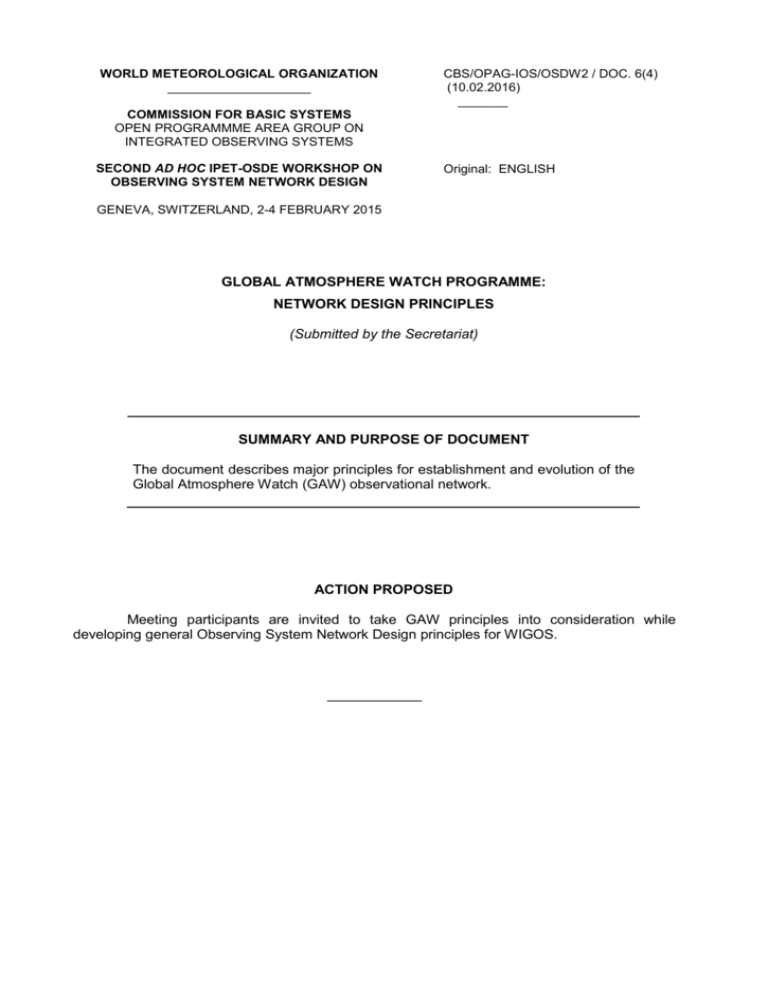
WORLD METEOROLOGICAL ORGANIZATION ____________________ CBS/OPAG-IOS/OSDW2 / DOC. 6(4) (10.02.2016) _______ COMMISSION FOR BASIC SYSTEMS OPEN PROGRAMMME AREA GROUP ON INTEGRATED OBSERVING SYSTEMS SECOND AD HOC IPET-OSDE WORKSHOP ON OBSERVING SYSTEM NETWORK DESIGN Original: ENGLISH GENEVA, SWITZERLAND, 2-4 FEBRUARY 2015 GLOBAL ATMOSPHERE WATCH PROGRAMME: NETWORK DESIGN PRINCIPLES (Submitted by the Secretariat) SUMMARY AND PURPOSE OF DOCUMENT The document describes major principles for establishment and evolution of the Global Atmosphere Watch (GAW) observational network. ACTION PROPOSED Meeting participants are invited to take GAW principles into consideration while developing general Observing System Network Design principles for WIGOS. ____________ CBS/OPAG-IOS/OSDW2 / DOC. 6(4), p. 2 GLOBAL ATMOSPHERE WATCH PROGRAMME: NETWORK DESIGN PRINCIPLES 1. The Global Atmosphere Watch (GAW) Programme is a WMO Programme that addresses atmospheric chemical composition and related physical characteristics of the global atmosphere. It consists of a coordinated system of networks of observing stations, methods, techniques, facilities and arrangements encompassing the many monitoring and related scientific assessment activities. 2. GAW addresses six groups of variables, namely stratospheric ozone and vertical ozone distribution, greenhouse gases, reactive gases, precipitation chemistry, aerosols (chemical and physical properties) and UV Radiation. The variables were included in the programme during different periods to address the environmental issues related to those variables. Hence, the maturity of supporting observational network and the spatial coverage for the different variables vary. 3. The Global Climate Observing System (GCOS) defined 50 Essential Climate Variables (ECVs) required to support the work of the UNFCCC and the IPCC. Several GAW observing networks are recognized by GCOS for atmospheric composition ECVs and follow GCOS observational principles. 4. GAW observational network consists of GAW Global and Regional stations and stations working within contributing networks. Information about stations is recorded in the GAW Station Information System (GAWSIS) operated by MeteoSwiss. GAWSIS is to be linked with the OSCAR database to provide information related to the GAW observational capacity. 5. GAW Global and Regional stations are accepted in the programme after consideration of their application by respective Scientific Advisory Groups or Environmental Pollution and Atmospheric Chemistry (EPAC) Scientific Steering Committee of the Commission for Atmospheric Sciences (CAS). The requirements to GAW Regional and Global stations are given in Annex A. Contributing networks are evaluated by relevant groups as individual entities to GAW. A challenge related to contributing networks is that they are designed for specific purposes which are not always completely aligned to the objectives of the GAW Programme. The networks are accepted in GAW if they have demonstrated traceability to the WMO/GAW standards, use measurement techniques comparable to the ones recommended by GAW and share their data openly (including through GAW mechanisms). Siting requirements as for GAW also apply to contributing stations. The inclusion of regional networks as contributing networks to GAW may cause spatial biases for some variables which must be accounted for. 6. Through its evolution GAW mostly focused on issues of global scale, rather than on regional priorities. This is reflected in the general requirements to GAW stations formulated in the GAW Strategic Plan for the period 2008-2015 (GAW Report No.172). A change of focus to better address user needs in specific application is foreseen in the new GAW Implementation Plan which will require the extension of the GAW observational network to include more diverse condition. Inclusion of a new category of stations (“local station”) has been discussed at the 16th session of CAS in 2013 and the requirements for such stations are currently under development. 7. GAW strives to implement “integrated” observing system including ground-based observations and satellite remote sensing though some difficulties related to this platform integration do exist. It is difficult to ensure that recommendations on vertical profile measurements using aircraft or other platforms are done with regular spatial resolution as these observations are rather done utilizing opportunities. GAW works to establish a dialogue with satellite agencies to ensure continuity of that component of the integrated observing system and a task team has been established between GAW and WIGOS to initiate that discussion in the wider context of the Rolling Review of Requirements process. 8. GAW observational network is highly heterogeneous due to a number of factors: CBS/OPAG-IOS/OSDW2 / DOC. 6(4), p. 3 - different level of understanding of diverse environmental issues (e.g interest in total ozone impact on weather initiated ozone observational network in 50s, acid precipitation and urban air pollution drove development of SO2 and precipitation chemistry observational network in 70s); - different level of maturity and complexity of measurement techniques for measurements of different parameters; - different level of capacity in Member countries to implement atmospheric composition measurements and different national priorities. To achieve a more representative observational network, in support of environmental issues, a requirement of regional representativeness of the GAW stations is followed. GAW strives to reach more ideal spatial homogeneity by continuously promoting this requirement among Members. 9. GAW does not have in its regulations or publications clearly laid out network design principles. The general considerations formulated in the GAW Strategic plan, Congress and Executive Council documents, regional association and CAS documents and individual Measurement Guidelines related to individual variables state that regions important for particular environmental issues should address the gaps in the observational network. Requirements to horizontal and vertical resolution of the observing network are to be driven by Rolling Review of Requirements process. RRR is currently being established for applications using atmospheric composition measurements. 10. An initial step to identify relevant application areas was done at the first meeting of GAW Task Team on Observational Requirements and Satellite Measurements as regards Atmospheric Composition and Related Physical Parameters that took place in WMO on 10-13 November 2014. 11. Network design is also impacted by the GAW Quality Management Framework (QMF) principles (listed in Annex B). The primary objectives of the GAW QMF are to ensure that the data in the World Data Centers, which are used in particular in support of decision making, are consistent, of known and adequate quality, supported by comprehensive metadata, and sufficiently complete to describe global atmospheric states with respect to spatial and temporal distribution. Requirements to the quality of data are formulated through Data Quality Objectives. 12. Annex C summarizes the consistency between OSND principles and GAW network management practices. ______________ CBS/OPAG-IOS/OSDW2 / DOC. 6(4), p. 4 ANNEX A Requirements to the GAW Regional stations 1. The station location is chosen such that, for the variables measured, it is regionally representative and is normally free of the influence of significant local pollution sources. 2. There are adequate power, air conditioning, communication and building facilities to sustain long term observations with greater than 90% data capture (i.e. <10% missing data). 3. The technical support provided is trained in the operation of the equipment. 4. There is a commitment by the responsible agency to long term observations of at least one of the GAW variables in the GAW focal areas (ozone, aerosols, greenhouse gases, reactive gases, UV radiation, precipitation chemistry). 5. The GAW observation made is of known quality and linked to the GAW Primary Standard. 6. The data and associated metadata are submitted to one of the GAW World Data Centres no later than one year after the observation is made. Changes of metadata including instrumentation, traceability, observation procedures, are reported to the responsible WDC in a timely manner. 7. If required, data are submitted to a designated data distribution system in near-real-time. 8. Standard meteorological in situ observations, necessary for the accurate determination and interpretation of the GAW variables, are made with known accuracy and precision. 9. The station characteristics and observational programme are updated in the GAW Station Information System (GAWSIS) on a regular basis. 10. A station logbook (i.e. record of observations made and activities that may affect observations) is maintained and is used in the data validation process. In addition to the characteristics of Regional stations, a GAW Global station should fulfil the following additional requirements, namely 11. Measure variables in at least three of the six GAW focal areas. 12. Have a strong scientific supporting programme with appropriate data analysis and interpretation within the country and, if possible, the support of more than one agency. 13. Make measurements of other atmospheric variables important to weather and climate including upper air radio sondes at the site or in the region. 14. Provide a facility at which intensive campaign research can augment the long term routine GAW observations and where testing and development of new GAW methods can be undertaken. _________________ CBS/OPAG-IOS/OSDW2 / DOC. 6(4), p. 5 ANNEX B Main principles of the GAW Quality Management Framework 1. Full support of the GCOS Climate Monitoring Principles 2. Network-wide use of only one reference standard or scale (primary standard). In consequence, there is only one institution that is responsible for this standard. 3. Full traceability to the primary standard of all measurements made by Global, Regional and Contributing GAW stations. 4. The definition of data quality objectives (DQOs). 5. Establishment of guidelines on how to meet these quality targets, i.e., harmonized measurement techniques based on Measurement Guidelines (MGs) and Standard Operating Procedures (SOPs). 6. Establishment of MGs or SOPs for these measurements. 7. Use of detailed log books for each parameter containing comprehensive meta information related to the measurements, maintenance, and 'internal' calibrations. 8. Regular independent assessments (system and performance audits). 9. Timely submission of data and associated metadata to the responsible World Data Centre as a means of permitting independent review of data by a wider community. _________________ CBS/OPAG-IOS/OSDW2 / DOC. 6(4), p. 6 APPENDIX C Observing System Network Design (OSND) Principles as applied in the Global Atmosphere Watch Programme 1. SERVING MANY APPLICATION AREAS GAW observations are aimed at serving many applications. Stations are recommended to perform observations of as many parameters as possible at each individual station. 2. MEETING USER REQUIREMENTS Currently user community is being consulted and requirements to be reflected in requirements database. 3. MEETING NATIONAL, REGIONAL AND GLOBAL REQUIREMENTS GAW was created to address rather global and regional issue than national. For a number of parameters design of the network to address national requirements (e.g. in the case of the short lived gases or aerosols) would require different network design. 4. DESIGNING APPROPRIATELY SPACED NETWORKS GAW indicates spatial gaps in the network in the Congress, EC and Regional Association documents and encourages the Members to address these gaps. 5. DESIGNING COST-EFFECTIVE NETWORKS This is not implemented in GAW as we rely on the capacity of Members. Though GAW uses opportunities provided by contributing networks and encourages regional and national networks to join GAW if they are compatible with GAW protocols. 6. ACHIEVING HOMOGENEITY IN OBSERVATIONAL DATA GAW implements Quality Management System with harmonized measurement techniques, regular comparison campaigns and checks in the Data Centres to achieve homogeneity of observational data. 7. DESIGNING THROUGH A TIERED APPROACH This principle is embedded in the GAW Quality Assurance System. 8. DESIGNING RELIABLE AND STABLE NETWORKS GAW station requirement include the request for continues long-term uninterrupted operation of stations. 9. MAKING OBSERVATIONAL DATA AVAILABLE GAW practises open data policy. Observational data are submitted by Members to the dedicated data centres and are made freely available. 10. PROVIDING INFORMATION SO THAT THE OBSERVATIONS CAN BE INTERPRETED Observational data submitted to the data centres require accompanying metadata and flagging that can be used to interpreted observational data. Stations are required to have detailed log book to support their observations. The synchronization of the flagging between different data centres is on-going work. 11. ACHIEVING SUSTAINABLE NETWORKS GAW is a research programme. Unfortunately recent attempts to move atmospheric composition measurements to operational mode led to loss of quality of observations and data gaps are due to CBS/OPAG-IOS/OSDW2 / DOC. 6(4), p. 7 limited capacity and experience within the operational community. Research support is still needed to support atmospheric composition observations at the required quality level. 12. MANAGING CHANGE Individual measurement guidelines and standard operating procedures contain information on required overlap period between different systems to ensure consistency of the data sets from the same station. _________________
